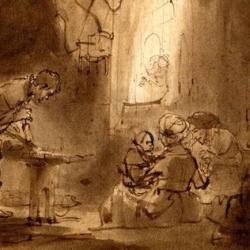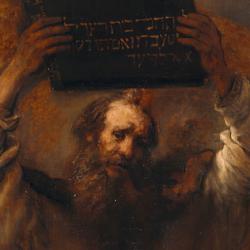The Greek word “plague” (plege) is used 16 times in the book of Revelation, but twice we get a count of plagues. The hyacinth army of Revelation 9 breathes out the “three plagues” of fire, smoke, brimstone (9:18). Those plagues show up later (14:10-11 [all three]; 19:20; 20:10; 21:8 [fire and brimstone without smoke]), but they first appear as the weapons of the myriad-of-myriads army.
After the grapes have been harvested (14:17-20), angels appears with “seven plagues, the last” (15:2). These are the plagues poured out from the bowls filled with the wine-wrath of the Lord.
Three plagues plus seven plagues equals ten plagues.
And that is significant, since there are ten plagues against Egypt in the book of Exodus. There is overlap between the plagues of exodus and those of Revelation: The two witnesses turn water to blood (11:6); there are frogs (16:12-13); hail falls several times, heavily (16:17-21); darkness falls when the lights of heaven are struck (8:12; 9:2; 16:10). The creatures from the abyss are like locusts (9:3, 7), and there might an analogy between the boils that torment the Egyptians and the stings of the locorpions (9:4-5). There is not a complete overlap, and the plagues of Revelation don’t follow the sequence of the Exodus plagues. But the parallels are there.
Perhaps more significantly is the distinction of plagues into two sets, one of three and another of seven. That same pattern is evident in Exodus. The first three plagues (blood, frogs, lice) afflicted Israelites and Egyptians alike; after the third plague, Yahweh made a distinction between Israel and Egypt (Exodus 8:22). Israel suffered no flies, pestilence, boils, hail or locusts; they had light when Israel was in darkness; and if they displayed the blood of the Passover their firstborn sons were delivered from death.
The first three plagues were directed against Israel as well as Egypt because Israel had become an Egypt, worshiping Egyptians gods as Joshua charged (Joshua 24). The first plagues were indiscriminate, but they served to pull Israel away from Egypt. Any Israelite who wanted to avoid more grief would be careful not to associate much with Egyptians.
Is there a similar sequence in the 3 + 7 plagues of Revelation? Do the first three plagues separate out an Israel from idolaters? There’s no obvious reason to think so, but little in Revelation is obvious.
Try this: The first three plagues come at the climax of the trumpet section of the book, the first of three visions opened up by the sixth trumpet (9:13). The sixth seal that precedes it includes a vision of a separated multitude, 144,000 sealed on the forehead with the seal of God, and so distinguished from the remainder of mankind, of the dwellers of the land (7:1-8). If the six-positioned visions correspond, then we might see the three plagues in chapter 9 as a development of the sixth-seal separation of the slaves of God. The last seven plagues are mentioned in the climactic scene of Revelation 12-15, after the 144,000 have been harvested (ch. 14).
If we squint, we can perhaps see this sequence: Sealing of 144,000; first three plagues that further distinguish them from the rest; harvest; final seven plagues, now carried out on a world form which the sealed slaves of God have been removed.
Or, to put it in other terms: Pre- or mid-trib rapture, only taking place in the 60s AD.














